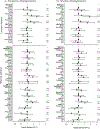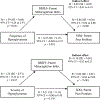Executive function and behaviour problems in school-age children born at risk of neonatal hypoglycaemia
- PMID: 36722028
- PMCID: PMC10387501
- DOI: 10.1111/dmcn.15520
Executive function and behaviour problems in school-age children born at risk of neonatal hypoglycaemia
Abstract
Aim: To examine the relationship between neonatal hypoglycaemia and specific areas of executive function and behaviour in mid-childhood.
Method: Participants in a prospective cohort study of infants born late preterm or at term at risk of neonatal hypoglycaemia were assessed at 9 to 10 years. We assessed executive function using performance-based (Cambridge Neuropsychological Tests Automated Battery) and questionnaire-based (Behavior Rating Inventory of Executive Function) measures and behaviour problems with the Strengths and Difficulties Questionnaire. Data are reported as adjusted odds ratio (aOR) with 95% confidence intervals, and standardized regression coefficients.
Results: We assessed 480 (230 females, 250 males; mean age 9 years 5 months [SD 4 months, range 8 years 8 months-11 years 0 months]) of 587 eligible children (82%). There were no differences in performance-based executive function between children who did and did not experience neonatal hypoglycaemia (blood glucose <2.6 mmoL/L). However, children who experienced hypoglycaemia, especially if severe or recurrent, were at greater risk of parent-reported metacognition difficulties (aOR 2.37-3.71), parent-reported peer (aOR 1.62-1.89) and teacher-reported conduct (aOR 2.14 for severe hypoglycaemia) problems. Both performance- and questionnaire-based executive functions were associated with behaviour problems.
Interpretation: Neonatal hypoglycaemia may be associated with difficulties in specific aspects of parent-reported executive functions and behaviour problems in mid-childhood.
© 2023 The Authors. Developmental Medicine & Child Neurology published by John Wiley & Sons Ltd on behalf of Mac Keith Press.
Figures


References
-
- Cornblath M, Hawdon JM, Williams AF, Aynsley-Green A, Ward-Platt M, Schwartz R, et al. Controversies regarding definition of neonatal hypoglycemia: Suggested operational thresholds. Pediatrics 2000; 105: 1141–5. - PubMed
-
- Burns CM, Rutherford MA, Boardman JP, Cowan FM. Patterns of cerebral injury and neurodevelopmental outcomes after symptomatic neonatal hypoglycemia. Pediatrics 2008; 122: 65. - PubMed
Publication types
MeSH terms
Grants and funding
LinkOut - more resources
Full Text Sources
Medical

